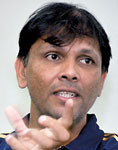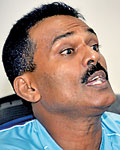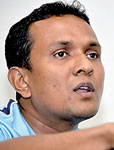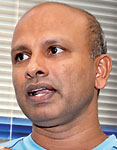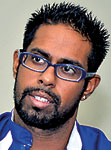Was the human body created to bowl fast by whomever the creator he was. The answer is a definite no. At the same time the game of cricket apparently took its roots in the cooler climes of England where the bone structure of the homosapiens are heavier to bear the extra pounds of flesh and body fats that are needed to combat the chilly winters.
Yes, the Englishmen who ruled over the Indian subcontinent initially brought the game over to this region as one of their own recreations – one of the ways of burning out their excess winter fats. But, maybe the very structure of the game – laid back and spread over a period of time -- appealed to the people of this region. Though being small in stature and lighter-boned they dived into the game of cricket and took to it as if it was one of their own derivations.
As time went by, the game took to two distinctive avenues. The heavily-boned populace from the cooler climes opted to bowl fast on hard and bouncy tracks and had the batsman playing on the back foot while the lighter boned gentry opted for the slow and low turning wickets more akin to spin bowling and played on the front foot.
In present day cricket this is the basic divide. Cricketers from the Indian sub-continent produce better spinners and keep the bigger boned guessing and doing the tango on the crease while the lads from the cooler climes keep the lighter boned counterparts ducking for cover.
All these thoughts kept running through my mind, when I was pondering about the plight of Sri Lanka fast bowling department in the post-Vaas era, where we cannot find bowlers operating in tandem with good rhythm and worrying the opposition and taking wickets. Reason: more or less they are injured more often than not and it has become a serious backward step in our cricketing progress chart.
With this in mind, I took a trip to the R. Premadasa Cricket Stadium, where Sri Lanka’s Centre for Cricket excellence is situated, to meet Sri Lanka Cricket’s head of coaching Jerome Jayaratne who explained to us what’s being done and what has to be done with his panel of experts in cricket grooming and nursing.
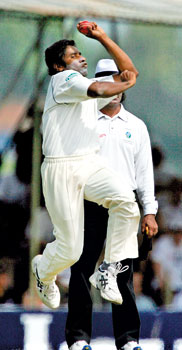 |
| Chaminda Vaas the only Lankan seamer who stayed free of injury for over a decade. |
Apart from Jerome Jayaratne, the panel included Anusha Samaranayake (fast bowling coach), Ranjith Nanayakkara and Ajantha Wattegama (physiotherapists) and Dharshana Weerasinghe (strength and conditioning), who is now in Australia with the national team.
They spoke in unison. “First we must understand in countries like England, Australia, South Africa or even New Zealand there are facilities of this nature in every province, while we possess only this to serve the whole nation. In those countries, in every province or region you get specialized coaches in every aspect of the game. Here we can’t look after the needs of the entire country, so there are the schools, private coaching organizations and the filtering systems.”
Then the coaching unit members also pointed out that within the last five years or so the volume of cricket played in this country at all levels also had increased several fold. For instance, the number of schools that played junior cricket had increased from 250 to 600 in the last five years.
This means to facilitate this, there should be an increase in the number of support staff in the country. This also means that there is a general drop in the quality of coaches that are spread throughout this whole gamut.
Jayaratne pointed out that at one point of time in the past there were school coaches like Gerry Gunaratne, F.C. de Saram, Alex Wijesinghe and P.W. Perera handling the nurseries, but today we do not know what kind of cricket that some of the coaches have played.
“From our perspective what we try to do is to scout for the young talent from the age of 15-16 and take them into the system,” he said.
He explained that in Sri Lanka as the main base is situated in Colombo and the rest of the coaches are spread individually throughout the island “we cannot give the same intensity in moulding the cricketers from the outstations as cricketing nations do”.Coming into the main peripheries of club cricket and international cricket the anomalies remain the same. What the coaching unit sees as a major drawback is within the inherent body structure of the people of these climes. Sri Lanka does not produce many fast bowlers who operate consistently at speeds of 140+. So with the given lot that the island possesses the unit has to manage injuries and then keep the stock of fit bowlers enough to operate at international level.
The core problems crop up at this point. As a matter fact injuries are an inherent part of fast bowling. Unless the fast bowler is an exceptional athlete like Chaminda Vaas who knew how to manage his skills and the fitness level cohesively to stay injury-free through most of his international and first class career. Then when a fast bowler is injured it is up to the unit to manage his injury, rehabilitate him and gradually get him back into the demands of international cricket. Yet one of the biggest problems that they encounter is the recuperation of the athlete. As there are frequent breakdowns in the international circuit the recuperation period of a fast bowler who is under rehabilitation becomes shorter.
They said that several years ago once a fast bowler was injured, he was rehabilitated and gradually exposed to local cricket and then got him back into peak level before releasing into the national grid once again.
But today even the volume of international cricket has increased. In addition to that, most of the international fast bowlers are involved with private circuses like the IPL. This means the injury management becomes a difficult task. In most instances the bowlers are drafted back into the international fold before he could complete his fitness regime after recuperation.
Another drawback is most of the clubs tend to underutilise the fast bowlers as a result of the existing wickets that are prepared for the local tournaments. So much so Chilaw Marians’ fast bowler Shaminda Eranga who impressed in his Test debut against Australia before getting injured had bowled fewer than fifty overs in an entire season.
Then when it came to the real challenge of Test cricket where you have to bowl 30 overs an innings the bowlers tend to break down. At the same time even the local cricket tournaments also tend to run through the year. Then even a player who is involved in local tournaments also does not get time to rehabilitate their bodies and let the wear and tear of the season grow back to its normal regime. |



